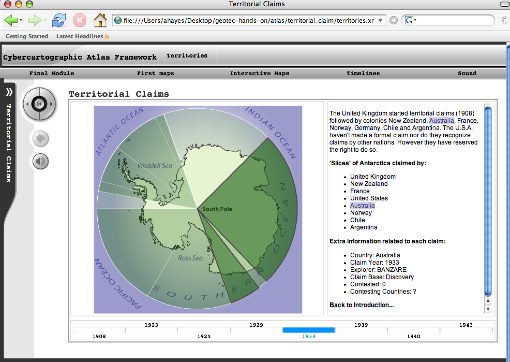Open Research
The Nunaliit Cybercartographic Atlas Framework was born out of a multi-disciplinary research project led by Dr. Fraser Taylor, a Distinguised Research Professor in the department of Geography and Environmental Studies and director of the Geomatics and Cartographic Research Centre at Carleton University in Ottawa, Canada.
The 4-year Cybercartography and the New Economy (CNE) project is funded by the Social Sciences and Humanities Research Council of Canada and seeks to develop the theory and practice of cybercartography - a concept that takes a holistic approach to information and sees the map as a central unifying principle.
The Nunaliit framework aims to make it easy for anyone to build a cybercartographic atlas - telling stories and exploring the relationships between space, time, knowledge, and our senses. Initial development has focused on an XML schema for organizing and connecting content into a meaningful state, and a compiler to render that information out to an interactive web interface. This system is quite usable now, if you're comfortable with XML.
Future developments will see great improvements for creators as the tools to contribute, link, and tell stories around content and maps are built and integrated. Our goal is to have cybercartographic story-telling be as simple as working with collaborative web technologies like Wiki is today.
Examples
Cybercartographic Atlas of Antarctica - Territorial Claims module

The following sample Quicktime movies were produced to show the work that has been done by the project to introduce sound to cartography. They are all rendered in the Nunaliit framework.
Sample movies:
- Antarctic Atlas Prototype Exploration Module
- Antarctic Atlas Prototype Territorial Claims Module
- Antarctic Atlas Prototype Intro Module
Credits
To date, numerous individuals have contributed to the Nunaliit framework in some capacity through the CNE project. The list of CNE project participants gives some idea of the breadth of study that informed much of the theory and concepts upon which Nunaliit was built.
The Nunaliit framework development itself consitutes only a fraction of the CNE project and a few people deserve special mention for their participation on the production team.
- The vast majority of the code is written by Jean-Pierre Fiset from ClassOne Technologies Inc., as are the XML schemas at the heart of the framework.
- Glenn Brauen, a PhD candidate and Research Assistant with the Geomatics and Cartographic Research Centre (GCRC), continues to provide the bulk of the sound code within the framework.
- Sebastien Caquard (Post Doctoral Fellow), Peter Pulsifer (PhD Candidate), and Brian Eddy (PhD Candidate), also from the GCRC, along with students from assorted masters programs were responsible for feeding the development team with content and wishes that were critical to setting priorities for development.
- The default interface was conceived and designed by researchers led by Avi Parush at Carleton's Human Oriented Technology lab with assistance from students from Carleton's Industrial Design program.
- Amos Hayes with the GCRC is responsible for managing Nunaliit development as well as its application to atlas and proof of concept deliverables within the CNE project.
More thank-yous and kudos are located in the LICENSE.txt file contained in the Nunaliit packages.
The License
As an output of a publically funded research project, it was important for us to release the Nunaliit code under a license that permits broad adoption of the software and encourages use of the ideas as widely as possible. We have chosen the New BSD License as it permits use, redistribution, and modification by anyone with no obligation to make the modifications available for others. That being said, we expect that individuals and organizations, whether for profit or not, will see the benefits of contributing their effort back to the nunaliit community. Please see the Community and Developers sections of this site to contribute.
Web Site Design
The Nunaliit web site is maintained by Amos Hayes. Please email me with comments or questions. The web site design is based on a CSS template freely distributed by Andreas Viklund. He makes some neat music too.

